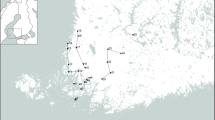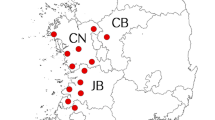Abstract
To narrow the gap of missing knowledge on Rickettsia spp. and Anaplasma phagocytophilum infections in ticks in northwestern Germany and, at the same time, to provide first prevalence data on these pathogens in the city of Hamburg, a total of 1,400 questing Ixodes ricinus ticks were collected at ten different public green areas from April until October 2011. Ticks were examined using probe-based quantitative real-time PCR. A percentage of 3.6 % (51/1,400) ticks were tested positive for A. phagocytophilum infections divided into 2.1 % (3/141) adults [1.7 % (1/60) females and 2.5 % (2/81) males] and 3.8 % (48/1,259) nymphs. The percentage of infected ticks per sampling site varied statistically significantly from 0.7 % (1/140) to 12.1 % (17/140), whereas between sampling months, no statistically significant differences were observed (2.0–6.5 %, 4–13/140). The overall Rickettsia spp. infection rate was 52.5 % (735/1,400). In adult ticks, Rickettsia spp. infection rate was 56 % (79/141) divided into 61.7 % (37/60) infected females and 51.9 % (42/81) infected males. Nymphs showed an infection rate of 52.1 % (656/1,259). In contrast to A. phagocytophilum infections, no statistically significant differences in Rickettsia spp. infection rates among sampling sites (44.3–63.6 %, 62–89/140) were observed, whereas seasonal variations were obvious: the percentage of Rickettsia-positive ticks was significantly lower in April (36.5 %, 73/200) and May (29.5 %, 59/200) compared to the summer and fall months (55.0–64.5 %, 110–129/200). Rickettsia species differentiation via real-time pyrosequencing revealed Rickettsia helvetica as the only occurring species. Co-infections with both Rickettsia spp. and A. phagocytophilum were detected in 2.0 % (28/1,400) of the ticks. The present study revealed that in the city of Hamburg, the tick infection rate with A. phagocytophilum is comparable with other German data, whereas the Rickettsia spp. infection rate of 52.5 % is by far the highest prevalence detected in Germany so far. As the city of Hamburg has 1.8 million inhabitants and attracts millions of tourists every year, the potential health risk should not be underestimated.


Similar content being viewed by others
References
Aureli S, Foley JE, Galuppi R, Rejmanek D, Bonoli C, Tampieri MP (2012) Anaplasma phagocytophilum in ticks from parks in the Emilia-Romagna region of northern Italy. Vet Ital 48:413–423
Baumann D, Pusterla N, Peter O, Grimm F, Fournier PE, Schar G, Bossart W, Lutz H, Weber R (2003) Fever after a tick bite: clinical manifestations and diagnosis of acute tick bite-associated infections in northeastern Switzerland. Dtsch Med Wochenschr 128:1042–1047
Christova I, Van De Pol J, Yazar S, Velo E, Schouls L (2003) Identification of Borrelia burgdorferi sensu lato, Anaplasma and Ehrlichia species, and spotted fever group Rickettsiae in ticks from Southeastern Europe. Eur J Clin Microbiol Infect Dis 22:535–542
Cotte V, Bonnet S, Cote M, Vayssier-Taussat M (2010) Prevalence of five pathogenic agents in questing Ixodes ricinus ticks from western France. Vector Borne Zoonotic Dis 10:723–730
Dobler G, Wolfel R (2009) Typhus and other rickettsioses: emerging infections in Germany. Dtsch Arztl Int 106:348–354
Fournier PE, Grunnenberger F, Jaulhac B, Gastinger G, Raoult D (2000) Evidence of Rickettsia helvetica infection in humans, eastern France. Emerg Infect Dis 6:389–392
Franke J, Fritzsch J, Tomaso H, Straube E, Dorn W, Hildebrandt A (2010) Coexistence of pathogens in host-seeking and feeding ticks within a single natural habitat in Central Germany. Appl Environ Microbiol 76:6829–6836
Franke J, Hildebrandt A, Meier F, Straube E, Dorn W (2011) Prevalence of Lyme disease agents and several emerging pathogens in questing ticks from the German Baltic coast. J Med Entomol 48:441–444
Ghera P, Kasirye Y, Choudhry MW, Shaw GR, Ejercito VS (2011) Acute transient sensorineural hearing loss due to Anaplasma phagocytophilum. WMJ 110:288–290
Gray JS, Dautel H, Estrada-Pena A, Kahl O, Lindgren E (2009) Effects of climate change on ticks and tick-borne diseases in Europe. Interdiscip Perspect Infect Dis 2009:593232
Gribble DH (1969) Equine ehrlichiosis. J Am Vet Med Assoc 155:462–469
Hartelt K, Oehme R, Frank H, Brockmann SO, Hassler D, Kimmig P (2004) Pathogens and symbionts in ticks: prevalence of Anaplasma phagocytophilum (Ehrlichia sp.), Wolbachia sp., Rickettsia sp., and Babesia sp. in Southern Germany. Int J Med Microbiol 293(Suppl 37):86–92
Hildebrandt A, Schmidt KH, Wilske B, Dorn W, Straube E, Fingerle V (2003) Prevalence of four species of Borrelia burgdorferi sensu lato and coinfection with Anaplasma phagocytophila in Ixodes ricinus ticks in central Germany. Eur J Clin Microbiol Infect Dis 22:364–367
Hildebrandt A, Kramer A, Sachse S, Straube E (2010) Detection of Rickettsia spp. and Anaplasma phagocytophilum in Ixodes ricinus ticks in a region of Middle Germany (Thuringia). Ticks Tick Borne Dis 1:52–56
Hudson JR (1950) The recognition of tick-borne fever as a disease of cattle. Br Vet J 106:3–17
Janecek E, Streichan S, Strube C (2012) SNP-based real-time pyrosequencing as a sensitive and specific tool for identification and differentiation of Rickettsia species in Ixodes ricinus ticks. BMC Infect Dis 12:261
MacLeod J, Gordon WS (1933) Studies on tick-borne fever in sheep. I. Transmission by the tick Ixodes ricinus and description of the disease produced. Parasitology 25:273–283
Mediannikov O, Matsumoto K, Samoylenko I, Drancourt M, Roux V, Rydkina E, Davoust B, Tarasevich I, Brouqui P, Fournier PE (2008) Rickettsia raoultii sp. nov., a spotted fever group rickettsia associated with Dermacentor ticks in Europe and Russia. Int J Syst Evol Microbiol 58:1635–1639
Ogden NH, Bown K, Horrocks BK, Woldehiwet Z, Bennett M (1998) Granulocytic Ehrlichia infection in ixodid ticks and mammals in woodlands and uplands of the U.K. Med Vet Entomol 12:423–429
Ogden NH, Casey AN, French NP, Bown KJ, Adams JD, Woldehiwet Z (2002) Natural Ehrlichia phagocytophila transmission coefficients from sheep ‘carriers’ to Ixodes ricinus ticks vary with the numbers of feeding ticks. Parasitology 124:127–136
Parola P, Rovery C, Rolain JM, Brouqui P, Davoust B, Raoult D (2009) Rickettsia slovaca and R. raoultii in tick-borne Rickettsioses. Emerg Infect Dis 15:1105–1108
Pichon B, Kahl O, Hammer B, Gray JS (2006) Pathogens and host DNA in Ixodes ricinus nymphal ticks from a German forest. Vector Borne Zoonotic Dis 6:382–387
Pusterla N, Pusterla JB, Deplazes P, Wolfensberger C, Muller W, Horauf A, Reusch C, Lutz H (1998) Seroprevalence of Ehrlichia canis and of canine granulocytic Ehrlichia infection in dogs in Switzerland. J Clin Microbiol 36:3460–3462
Reis C, Cote M, Paul RE, Bonnet S (2011) Questing ticks in suburban forest are infected by at least six tick-borne pathogens. Vector Borne Zoonotic Dis 11:907–916
Richter J, Fournier PE, Petridou J, Haussinger D, Raoult D (2002) Rickettsia felis infection acquired in Europe and documented by polymerase chain reaction. Emerg Infect Dis 8:207–208
Schicht S, Junge S, Schnieder T, Strube C (2011) Prevalence of Anaplasma phagocytophilum and coinfection with Borrelia burgdorferi sensu lato in the hard tick Ixodes ricinus in the city of Hanover (Germany). Vector Borne Zoonotic Dis 11:1595–1597
Schicht S, Schnieder T, Strube C (2012) Rickettsia spp. and coinfections with other pathogenic microorganisms in hard ticks from northern Germany. J Med Entomol 49:766–771
Schorn S, Pfister K, Reulen H, Mahling M, Silaghi C (2011) Occurrence of Babesia spp., Rickettsia spp. and Bartonella spp. in Ixodes ricinus in Bavarian public parks, Germany. Parasit Vectors 4:135
Sen E, Uchishima Y, Okamoto Y, Fukui T, Kadosaka T, Ohashi N, Masuzawa T (2011) Molecular detection of Anaplasma phagocytophilum and Borrelia burgdorferi in Ixodes ricinus ticks from Istanbul metropolitan area and rural Trakya (Thrace) region of north-western Turkey. Ticks Tick Borne Dis 2:94–98
Severinsson K, Jaenson TG, Pettersson J, Falk K, Nilsson K (2010) Detection and prevalence of Anaplasma phagocytophilum and Rickettsia helvetica in Ixodes ricinus ticks in seven study areas in Sweden. Parasit Vectors 3:66
Silaghi C, Gilles J, Hohle M, Pradel I, Just FT, Fingerle V, Kuchenhoff H, Pfister K (2008) Prevalence of spotted fever group rickettsiae in Ixodes ricinus (Acari: Ixodidae) in southern Germany. J Med Entomol 45:948–955
Silaghi C, Woll D, Hamel D, Pfister K, Mahling M, Pfeffer M (2012) Babesia spp. and Anaplasma phagocytophilum in questing ticks, ticks parasitizing rodents and the parasitized rodents—analyzing the host-pathogen-vector interface in a metropolitan area. Parasit Vectors 5:191
Simser JA, Palmer AT, Fingerle V, Wilske B, Kurtti TJ, Munderloh UG (2002) Rickettsia monacensis sp. nov., a spotted fever group Rickettsia, from ticks (Ixodes ricinus) collected in a European city park. Appl Environ Microbiol 68:4559–4566
Sirigireddy KR, Ganta RR (2005) Multiplex detection of Ehrlichia and Anaplasma species pathogens in peripheral blood by real-time reverse transcriptase-polymerase chain reaction. J Mol Diagn 7:308–316
Soleng A, Kjelland V (2013) Borrelia burgdorferi sensu lato and Anaplasma phagocytophilum in Ixodes ricinus ticks in Bronnoysund in northern Norway. Ticks Tick Borne Dis 4:218–221
Stamp JT, Watt JA, Jamieson S (1950) Tick-borne fever as a cause of abortion in sheep. Vet Rec 62:465–470
Stenos J, Graves SR, Unsworth NB (2005) A highly sensitive and specific real-time PCR assay for the detection of spotted fever and typhus group Rickettsiae. Am J Trop Med Hyg 73:1083–1085
Strube C, Montenegro VM, Epe C, Eckelt E, Schnieder T (2010) Establishment of a minor groove binder-probe based quantitative real time PCR to detect Borrelia burgdorferi sensu lato and differentiation of Borrelia spielmanii by ospA-specific conventional PCR. Parasit Vectors 3:69
Tappe J, Strube C (2013) Anaplasma phagocytophilum and Rickettsia spp. infections in hard ticks (Ixodes ricinus) in the city of Hanover (Germany): revisited. Ticks Tick Borne Dis 4:432–438
Telford SR 3rd, Dawson JE, Katavolos P, Warner CK, Kolbert CP, Persing DH (1996) Perpetuation of the agent of human granulocytic ehrlichiosis in a deer tick-rodent cycle. Proc Natl Acad Sci U S A 93:6209–6214
Wolfel R, Terzioglu R, Kiessling J, Wilhelm S, Essbauer S, Pfeffer M, Dobler G (2006) Rickettsia spp. in Ixodes ricinus ticks in Bavaria, Germany. Ann. N.Y. Acad Sci 1078:509–511
Author information
Authors and Affiliations
Corresponding author
Rights and permissions
About this article
Cite this article
May, K., Strube, C. Prevalence of Rickettsiales (Anaplasma phagocytophilum and Rickettsia spp.) in hard ticks (Ixodes ricinus) in the city of Hamburg, Germany. Parasitol Res 113, 2169–2175 (2014). https://doi.org/10.1007/s00436-014-3869-x
Received:
Accepted:
Published:
Issue Date:
DOI: https://doi.org/10.1007/s00436-014-3869-x




